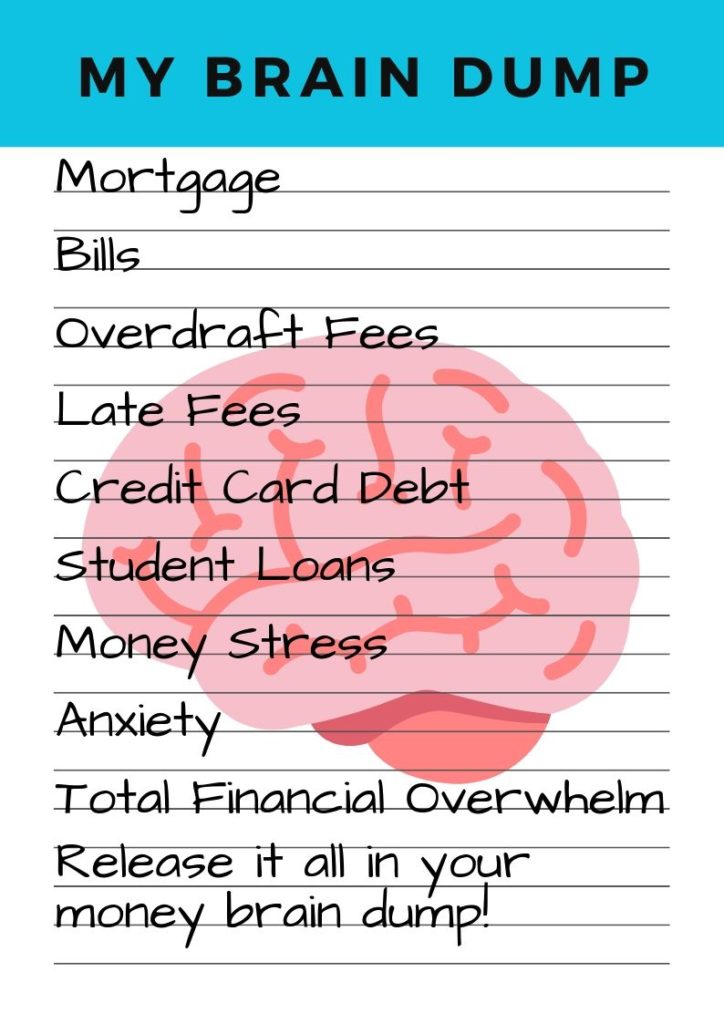It’s no secret that many Americans are completely frustrated and beaten down when it comes to their money. You may feel trapped or even paralyzed by the paycheck to paycheck cycle. There are tons of free resources about what to do with your money. Why can’t you seem to figure it out?
It’s because when you’re totally overwhelmed with your money situation, you don’t know where to actually start. You try to do all the things that a money savvy person is supposed to do, but it’s just NOT working.
According to a study by CareerBuilder, 78% of U.S. workers live paycheck to paycheck. An article by CNBC states that 56% of adults are losing sleep over money, and that money is the second most common source of stress for Americans.
Take heart that you’re not alone! Losing sleep and stressing over money is a big part of the overwhelm when it comes to finances. Obviously, if you can minimize that stress and burden by improving your financial situation, then even your health will improve.
So where do you start?
Most experts will share all the steps you need to take to minimize the overwhelm. It’s great advice, and following those steps can get you far. But that advice also tends to paralyze so many because it’s just a long list of to-dos. It’s hard to process and especially to take action on when you’re in this situation to begin with.
***Grab the FREE download 3 Things NOT to do if you want to become less overwhelmed and more organized with your money! Plus discover what to do instead!***
Now, are you ready for a completely different approach?
Let’s take a step back and I’ll let you in on a little secret for overwhelm that I don’t hear about often enough.
It’s called a brain dump. But this time we’re not doing a typical “life” brain dump. What I’m talking about is a financial brain dump.
What is a brain dump?
Let’s talk about a good ole regular brain dump first. You have probably heard of it. It’s talked about in David Allen’s book Getting Things Done and all over the internet in productivity articles.
A brain dump is where you “empty your head” of everything in it and write it all down on paper instead. In other words, you take all those thoughts constantly entering your mind and taking up space, and transfer them to paper instead.
During times of overwhelm and especially paralysis (when you can’t do anything because you’re so overburdened by everything that needs to be done), it is so helpful to sit down and clear your head.
What is a financial brain dump?
A financial brain dump works the same as a regular brain dump with one exception. It deals only with your thoughts about money and any aspect of your life that affects your money.

It’s thinking specifically about your financial situation and writing any and all of those thoughts down.
Don’t hold back. Anything money-related at all should be written down as you think about it.
Focus on everything you stress about when it comes to your money, as well as financial tasks you know you need to take care of. Those items include everything you need to do, have thought about doing, should be doing, or even should think about doing.
Deep down, you know that worrying about things and constantly filling your mind with those anxious thoughts doesn’t help the situation. It just adds to the stress and overwhelm, and completely paralyzes you from doing anything.
Instead, get it all out of your head and onto paper! This will help release that worry and even allow you to start taking action!
How do you complete a financial brain dump?
The rest of this article will show you how to effectively brain dump when it comes to financial overwhelm.
First, grab a few sheets of blank paper and a pen.
Then it’s time to sit down and let your mind run free with all of your worries, stressors, thoughts, ANYTHING dealing with your money. Instead of letting all these things swim around in your head and keep you stressed and worried, get them written out on paper.
As you think these things, write them down on a piece of paper to get them out of your head. You will be surprised that just this action alone can help you stop worrying so much about finances.
Remember, the purpose of this exercise to get your mind emptied. Don’t start thinking about how to solve the problem. Instead, just write down all your thoughts. It’s not only okay, but actually recommended, to be random and unorganized in all of your thoughts.
When beginning your financial brain dump, try these questions to get your mind started in the right direction.
When you think about your money, what is the first thought that comes to mind?
What problem or issue is stressing you out the most?
What about your money are you ignoring?
What were you searching for that made you click on this article to begin with?
If you could change anything about your money, what would it be?
When you lie awake at night thinking about money, what thoughts can you not seem to get rid of?
What do you think is most urgent for you to be doing with your money?
What are you not doing with your money that you wish you were?
What thought about money gives you the most anxiety?
What does true financial freedom look like to you?
Keep writing and let your mind roam freely about money until you feel your head is completely emptied onto the paper in front of you.

How much time should I spend doing a financial brain dump?
Take a few minutes to complete your initial brain dump, but then keep adding to it as needed.
First, sit down for a few minutes dedicated to this one task. Set a timer for anywhere from 5 to 15 minutes, and write down everything you think about regarding your money. Once the timer goes off, feel free to stop—but if you’re on a roll, it’s okay to keep going.
After the initial brain dump session, keep that sheet of paper accessible.
Anytime something pops into your head regarding your money or your feelings about money, add it to the bottom of your current brain dump list!
Don’t sit there, dwell on it, or stress about it. Just write it down and get it out of your head.
Once you have this list and all your money thoughts are out of your head, then it’s time to figure out where to focus.
Where should I start after getting all of the overwhelming money thoughts out of my head and onto paper?
Now is the time where you zone in on these thoughts, organize them, and start to figure out some actionable solutions.
Set a timer for 15 minutes this time and begin to process your list. Fifteen minutes gives you the motivation to start thinking about how to overcome these overwhelming things and it also gives you the freedom to stop when the timer goes off!

***Don’t forget to grab the FREE download 3 Things to QUIT DOING if you want to become less overwhelmed and more organized with your money!***
Overall, you want to decide which items are most urgent and what you can do to gain control and stop worrying about your money.
You know that worrying does you no good. It doesn’t make anything better. It only stresses you out and doesn’t accomplish anything. So do your best to let go of the anxiety in your head and leave it on the paper.
As Craig Ballantyne says, “Action beats anxiety. Work beats worry.” You’re about to get rid of that anxiety and worry by taking action and getting to work!
Go down your brain dump page, line by line, and evaluate each item.
Is there anything you can actually take care of TODAY? Circle it. This could be just one thing or maybe even more than one.
For example, it may be a bill payment you’ve been procrastinating about paying. Pay the bill, knock it off your list, and then you’re done.
What if something can’t be taken care of that quickly? What if most of your brain dump items take multiple steps?
For example, what if you need to pay that bill, but you’re not sure the bank account has enough money to cover it? And…you can’t remember your password to log into your account. Then what?
Get out a separate sheet of paper and start to break those things down into baby steps that will need to happen to take care of the issue.
I’m somewhat overcomplicating this problem, just because I want to make this concept simple to understand.

If you feel too overwhelmed or frustrated to start, making a list of baby action steps is the place to start.
However, if you’re one of those people that jumps in and gets things done, you can skip the list-making and just get started!
Breaking down your financial brain dump list into baby action steps
Begin with the overall thought or problem (in this case, paying the bill) then write down any actions you need to take to eventually solve the problem.
Baby steps for the above bill paying problem are as follows: First, locate the password for your bank account (in a book you keep, on an app, in your spouse’s head…). If none of those work, contact your bank about setting up a new password. After logging in, check your bank account, and if money is there, pay the bill.
If money is not there, you’re most likely in a money crisis and you probably don’t know how things will be paid.
At that point, you have to decide if the next payday is close enough and start making sure all your bills and expenses will be taken care of with that paycheck.
Remember: we’re decreasing overwhelm. Do your best in this situation to avoid overdraft fees. Though they may seem like a quick fix, those will only add to overwhelm in the future. It’s time to think outside the box.
If you’re in a money crisis, you will need to get really serious and do some drastic things to get out.
Because there’s not enough money to pay the bills, it’s that much more important to keep your priorities straight. I love this informative post on financial priorities in a money crisis by Kimberlee at thepeacefulhome.com. If this is you, read it now!
If money crisis isn’t your issue, then use the same baby step process as above to decide what you should do next with your money.
 />
/>
Another example of a money issue on your brain dump you want to solve
Another example would be if you are robbing Peter to pay Paul every month. Or even borrowing money from family or friends to meet your monthly expenses.
In that case, the first baby step is to dive into your money and see what’s going on.
Look over your last two to three months of bank statements. Where is your money going? Is there anyway you can reduce some expenses? Start there and see what you can do!
What about increasing your income? You may need to get more money to cope financially. Whether you sell some things or offer your services to friends (babysitting, house cleaning, etc.), for some quick extra cash, this can be a good way to fill in the gaps for now.
Are overdraft fees stealing your hard-earned money? Set up texting or email bank alerts, then get in the habit to check those alerts before spending. Or to be really drastic (and effective!), let your bank know that you no longer want overdraft protection. You’ve just removed the opportunity and some of the temptation to overspend.
Brainstorm any other things you can do to solve the problem and list them all out. You are baby stepping your way to gaining control of your money and ridding yourself of so much stress! Congratulations!
After taking action on the easier items you can do today, then it’s time to move on to the harder parts of dealing with your money brain dump list.
Once you’ve taken care of the circled “today” items by either finishing the task, or mapping out the baby steps, then you can move on to the rest of your list.
Go back through your brain dump list, and decide what else you can start to work on.
This process is to help you decide the next best step for your money, and start to deal with some of the more difficult things. It’s also to help you dig into your money mindset and why you do the things you do.
Was overspending one of your stressors? Think about when you overspend and what causes it or triggers it. Is there one small thing you can start today to break that habit?
What about real fear or uncontrollable anxiety surrounding your money? Begin to research ways to overcome these feelings. This post on dealing with financial anxiety and overwhelm is a great place to start. Seeking professional help is also a good choice for many struggling in this area, especially if you’re completely unable to take any other action.

Take the time to process the most important and actionable items on your brain dump list.
Do NOT try to process all of them! Just one, maybe two, to get started. You list will always be there. Keep it, add to it to release the overwhelm, and then come back to it as you’re ready to tackle something else.
Remember, your goal is to decrease overwhelm, not make a longer to-do list that you won’t have time to accomplish anytime soon!
If your brain dump list is super long and too much for you to think about, or you really have no idea how to start processing it, please reach out to me! As a financial coach, I have training to pick out what is most important to focus on first and to guide you through it.
At the present moment, I do not charge to look over your brain dump list and give you some tips. Don’t hesitate to send me an email at pennystewardmama@gmail.com if you’d like some help!
Once you have started to clear your financial overwhelm with a brain dump, you have a much better picture on how you can turn your finances around.
Performing the brain dump is the act that helps release your overwhelm, and is exactly the place to start when thoughts about money are paralyzing you from taking action.
After the brain dump, figuring out your next best action step is critical to overcoming money problems.
That task could be super simple, like picking one quick thing to knock out today. It could also mean breaking down some of the bigger items or problems into baby steps. That will take a little more work, but will certainly move you forward in the right direction!
Stumped on figuring out your focus after the brain dump? Email me at pennystewardmama@gmail.com for my thoughts on your brain dump list!
Work through this process today, and you will be surprised and pleased with the results!
As always, continue to steward your money and life intentionally!
Heather
 />
/>
